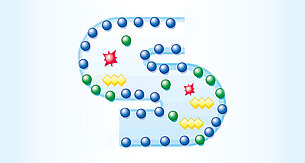Health Experts say “Avoid added sugars for children below 2 years”
The American Academy of Pediatrics (AAP) advise that children younger than the age of two should avoid added sugars in their diet as too much added sugar puts children at risk for obesity, tooth decay, heart disease, high cholesterol, high blood pressure, type 2 diabetes and fatty liver disease, among other health problems.1
The intake of added sugars is also strongly associated to dental diseases which are globally prevalent among children and cause pain, anxiety, poor school attendance and performance, and tooth loss affecting a child’s emotional behavior and social skills.2-8
Pursuing one of its principles that the healthy development of the child is of basic importance, The World Health Organization, likewise, advise to “Prohibit added sugars and other sweetening agents (including all syrups, honey, fruit juice, fruit juice concentrates or non-sugar sweeteners) in all commercial baby foods.”9
In comparison to natural sugars that are naturally occurring in fresh fruits, vegetables and milk, added sugars are those that are added to foods and beverages as ingredients during processing. Added sugars have many different names. In milk supplements, added sugars can include maltodextrin, corn syrup solids, hydrolysed cornstarch, glucose, fructose and sucrose.10
Human breastmilk has the natural milk sugar lactose which is packed with multiple health benefits and the energy needed for the child’s growth and development11.
At HiPP, we put children in the center of attention by carefully selecting ingredients that are closest to nature. HiPP Organic Combiotic® uses only the natural milk sugar Lactose, without the use of added sugars. Give your child HiPP Organic Combiotic®. Help support your child’s health and development with organic and naturally-sourced ingredients.
Reference:
1publications.aap.org/aapnews/news/7331
2Diet, nutrition and the prevention of chronic diseases: report of a Joint WHO/FAO Expert Consultation. WHO Technical Report Series, No. 916. Geneva: World Health Organization; 2003
(http://whqlibdoc.who.int/trs/WHO_TRS_916.pdf, accessed 27 February 2014).
3Diet, nutrition and the prevention of chronic diseases: report of a WHO Study Group. WHO Technical Report Series 797. Geneva: World Health Organization; 1990 (http://www.who.int/nutrition/ publications/obesity/WHO_TRS_797/en/, accessed 27 February 2014).
4Moynihan P, Petersen PE. Diet, nutrition and the prevention of dental diseases. Public Health Nutr. 2004; 7(1A):201–226 (http://www.ncbi.nlm.nih.gov/pubmed/14972061, accessed 17 January 2015).
5Sheiham A, James WP. A reappraisal of the quantitative relationship between sugar intake and dental caries: the need for new criteria for developing goals for sugar intake. BMC Public Health. 2014; 14:863 (http://www.ncbi.nlm.nih.gov/pubmed/25228012, accessed 17 January 2015).
6Sheiham A, James WP. A new understanding of the relationship between sugars, dental caries and fluoride use: implications for limits on sugars consumption. Public Health Nutr. 2014:1–9
(http://www.ncbi.nlm.nih.gov/pubmed/24892213, accessed 17 January 2015). References WHO| Guideline 47 Sugars intake for adults and children
7The World Oral Health Report 2003. Geneva: World Health Organization; 2003
(http://www.who.int/oral_health/media/en/orh_report03_en.pdf, accessed 27 February 2014).
8Marcenes W, Kassebaum NJ, Bernabe E, Flaxman A, Naghavi M, Lopez A et al. Global burden of oral conditions in 1990–2010: a systematic analysis. J. Dent. Res. 2013; 92(7):592–597
(http://www.ncbi.nlm.nih.gov/pubmed/23720570, accessed 17 January 2015).
9World Health Organization. Regional Office for Europe. (2019). Commercial foods for infants and young children in the WHO European Region: policy brief on two new reports by the WHO Regional Office for Europe. World Health Organization. Regional Office for Europe. https://apps.who.int/iris/handle/10665/346582
10Dietary Guidelines Advisory Committee. 2020. Scientific Report of the 2020 Dietary Guidelines Advisory Committee: Advisory Report to the Secretary of Agriculture and the Secretary of Health and Human Services pdf icon[PDF-6.89MB]external icon. US Department of Agriculture, Agricultural Research Service, Washington, DC.
11Gunnerud, U.; Holst, J.J.; Stman, E.; Björck, I. The glycemic, insulinemic and plasma amino acid responses to equicarbohydrate milk meals, a pilot-study of bovine and human milk. Nutr. J. 2012, 11, 83.





